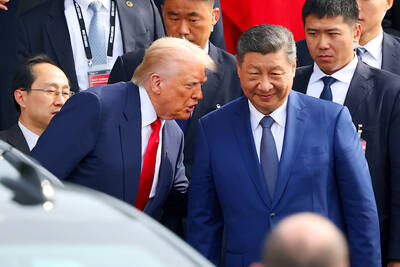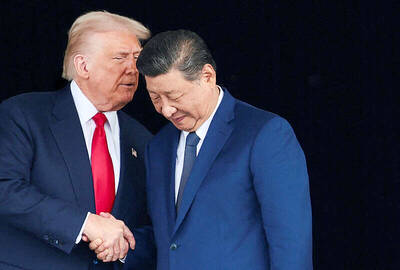Premier Wu Den-yih (吳敦義) yesterday said he and President Ma Ying-jeou (馬英九) had never opposed referendum bids launched in accordance with the law and denied that the government had changed its stance on holding referendums.
Wu made the remarks in the wake of a statement by Chinese Nationalist Party (KMT) Secretary-General King Pu-tsung (金溥聰) on Saturday that Ma and the KMT would not object should the Democratic Progressive Party (DPP) insist on pursuing a referendum on the proposed economic cooperation framework agreement (ECFA) with China after the legislature completes its review of the proposed cross-strait trade pact.
Given that Ma has said on numerous occasions that a referendum on an ECFA was unnecessary because the proposed agreement would not touch on political issues, King’s comments were perceived by some as a change of stance on the issue of an ECFA referendum by the Ma administration.
Dismissing such speculation, Wu yesterday said the government’s stance had not changed, as it has always supported lawful referendums.
Wu’s comments were called into question by DPP Chairperson Tsai Ing-wen (蔡英文) yesterday.
Tsai said the KMT had on previous occassions said it would not oppose a referendum, only to block the DPP’s attempt to hold one later by using administrative means.
She was referring to the DPP’s petition drive last year for a referendum on the ECFA issue.
The DPP wanted a referendum asking: “Do you agree that the government should put the ECFA that Taiwan plans to sign with China to a referendum?”
The petition was rebuffed by the Executive Yuan’s Referendum Review Committee despite passing an initial review by the Central Election Commission. The committee turned down the petition on the grounds that it was based on a hypothetical situation and therefore did not meet the criteria set down in the Referendum Act (公民投票法).
“If they truly recognize the importance of a referendum, they should give their support to it,” Tsai said, adding that if this were the case, KMT and DPP lawmakers could come together and support a referendum proposal in the legislature.
The Taiwan Solidarity Union (TSU) is currently petitioning for a referendum on the ECFA, with the backing of the DPP.
“The response we have received from the public and grassroots movements has been overwhelming,” TSU Associate Director Chou Ni-an (周倪安) said yesterday. “I think the government recognizes this and that is why all of a sudden the premier says the administration doesn’t oppose a referendum being held.”
Organizers expect to be able to deliver almost 200,000 signatures to the Referendum Review Committee later this week, more than double the 86,000 signatures needed to pass a first review.
The referendum would ask voters whether they wanted the government to sign any type of economic agreement with China, such as “President Ma Ying-jeou’s ECFA proposal.”
“The government has finally realized that there is a tide of popular support for putting this issue to the ballot box. After all, if Penghu County residents can vote on whether they want casinos, people nationwide should have a say on whether they support this controversial measure,” Chou said.
Also See: White-collar workers rally for complete ECFA debate

CALL FOR SUPPORT: President William Lai called on lawmakers across party lines to ensure the livelihood of Taiwanese and that national security is protected President William Lai (賴清德) yesterday called for bipartisan support for Taiwan’s investment in self-defense capabilities at the christening and launch of two coast guard vessels at CSBC Corp, Taiwan’s (台灣國際造船) shipyard in Kaohsiung. The Taipei (台北) is the fourth and final ship of the Chiayi-class offshore patrol vessels, and the Siraya (西拉雅) is the Coast Guard Administration’s (CGA) first-ever ocean patrol vessel, the government said. The Taipei is the fourth and final ship of the Chiayi-class offshore patrol vessels with a displacement of about 4,000 tonnes, Lai said. This ship class was ordered as a result of former president Tsai Ing-wen’s (蔡英文) 2018

UKRAINE, NVIDIA: The US leader said the subject of Russia’s war had come up ‘very strongly,’ while Jenson Huang was hoping that the conversation was good Chinese President Xi Jinping (習近平) and US President Donald Trump had differing takes following their meeting in Busan, South Korea, yesterday. Xi said that the two sides should complete follow-up work as soon as possible to deliver tangible results that would provide “peace of mind” to China, the US and the rest of the world, while Trump hailed the “great success” of the talks. The two discussed trade, including a deal to reduce tariffs slapped on China for its role in the fentanyl trade, as well as cooperation in ending the war in Ukraine, among other issues, but they did not mention

HOTEL HIRING: An official said that hoteliers could begin hiring migrant workers next year, but must adhere to a rule requiring a NT$2,000 salary hike for Taiwanese The government is to allow the hospitality industry to recruit mid-level migrant workers for housekeeping and three other lines of work after the Executive Yuan yesterday approved a proposal by the Ministry of Labor. A shortage of workers at hotels and accommodation facilities was discussed at a meeting of the legislature’s Transportation Committee. A 2023 survey conducted by the Tourism Administration found that Taiwan’s lodging industry was short of about 6,600 housekeeping and cleaning workers, the agency said in a report to the committee. The shortage of workers in the industry is being studied, the report said. Hotel and Lodging Division Deputy Director Cheng

‘SECRETS’: While saying China would not attack during his presidency, Donald Trump declined to say how Washington would respond if Beijing were to take military action US President Donald Trump said that China would not take military action against Taiwan while he is president, as the Chinese leaders “know the consequences.” Trump made the statement during an interview on CBS’ 60 Minutes program that aired on Sunday, a few days after his meeting with Chinese President Xi Jinping (習近平) in South Korea. “He [Xi] has openly said, and his people have openly said at meetings, ‘we would never do anything while President Trump is president,’ because they know the consequences,” Trump said in the interview. However, he repeatedly declined to say exactly how Washington would respond in